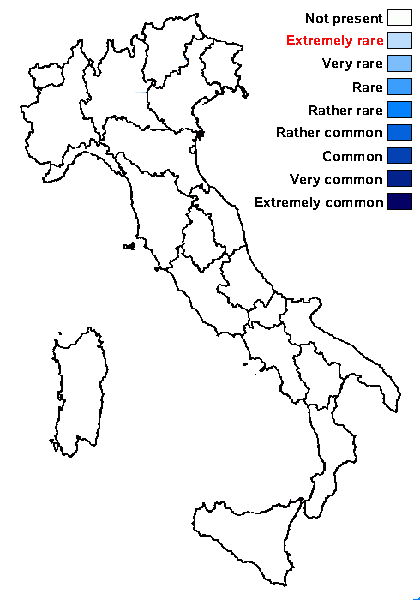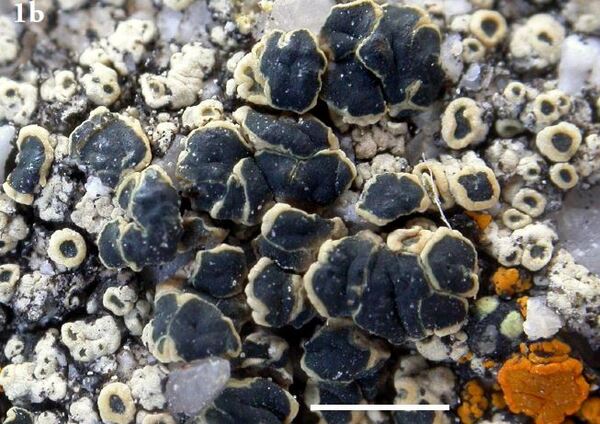Lecanora intricatoides M. Bertrand & Cl. Roux
in Roux & al., Bull. Soc. linn. Provence, 73: 93, 2022
Synonyms:
Distribution:
Description: Thallus crustose, thinly episubstratic, often poorly evident as largely hidden by apothecia, granulose or areolate, yellowish white, forming 0.4-2 cm wide patches. Areoles/granules round to polygonal, flattened, (0.05-)0.1-0.6 mm wide, 0.1-0.2 mm thick, most evident at the periphery of thallus, with blackish flanks. Cortex 40-50 μm thick, with a 13-22 μm thick epinecral layer filled with small and large crystals, and a 28-37 μm thick plectenchymatous layer divided into 2 sub-layers: an upper, brownish yellow layer with small yellowish crystals and usually larger colourless crystals soluble in N and in K, and a lower colourless layer devoid of, or poor in crystals; algal layer interrupted; medulla 50-120 μm thick, the hyphae surrounded by a few large, colourless crystals soluble in N, insoluble in K. Apothecia lecanorine, (0.2-)0.4-0.9(-1.1) mm across, round or deformed by mutual compression, sometimes confluent, at first adnate then sessile and constricted at base, with a dark grey-green to green-black, at first slightly concave, then flat disc and a 0.1-0.15(-0.2) mm thick, smooth and somehow glossy, finally often wavy and thinner thalline margin. Thalline exciple rather thick, corticate, the cortex with the same types of crystals as the thallus; proper exciple colourless, 60-80 μm thick in upper part, the hyphae with a fan-like arrangement, with an upper, paraplectenchymatous part rich in small yellowish crystals insoluble in N and soluble in K, and larger colourless crystals soluble in N, insoluble in K, and a prosoplectenchymatous lower part with small colourless crystals soluble in N. Epithecium yellowish brown, 10-15 μm high, with many small, yellowish crystals insoluble in N and soluble in K, and a few small, colourless crystals soluble in N and insoluble in K, N+ purple; hymenium colourless, 30-40 μm high, I+ blue; paraphyses simple or sparingly branched and anastomosing, 1.5-2 μm thick at base, the apical cells 3-4.5 μm wide; subhyménium colourless, 35-55 μm high, without crystals; hypothecium colourless, 15-30 μm high, I-. Asci 8-spored, clavate, Lecanora-type. Ascospores 1-celled, hyaline, ellipsoid, (8-)9-12(-13.5) x (4.5-)5-6.5(-7) μm, thin-walled. Pycnidia unknown. Photobiont chlorococcoid. Spot tests: cortex and apothecia (disc and margin) K+ yellow, C-, KC+ yellow, P-; medulla K-, C-, KC-, P-. Chemistry: unknown, probably usnic acid. Note: a recently-described silicicolous species found on horizontal to vertical surfaces, with optimum in the subalpine belt. Known from the Maritime Alps (France), to be looked for in Italy. The description is based on Roux & al. (2022).
Growth form: Crustose
Substrata: rocks
Photobiont: green algae other than Trentepohlia
Reproductive strategy: mainly sexual

Predictive model
Growth form: Crustose
Substrata: rocks
Photobiont: green algae other than Trentepohlia
Reproductive strategy: mainly sexual

Predictive model
 INDEX FUNGORUM
INDEX FUNGORUM
 GBIF
GBIF


